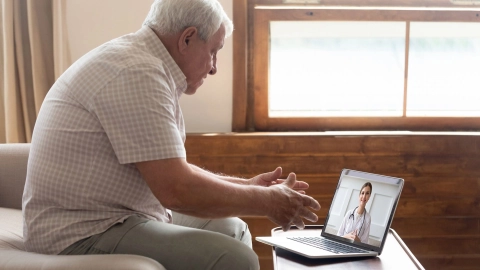Digital health Telemedicine: remote healthcare services
The term “telemedicine” covers a whole range of healthcare services provided at a physical and sometimes also temporal distance, for example, via telephone, apps or the internet.
At a glance
- Telemedicine enables remote medical care using digital media, for example, in a video consultation.
- It is especially helpful for providing care to people who are less mobile or live in rural areas.
- Another area of application of telemedicine is telemonitoring: the remote monitoring and examination of health parameters.
- Telemedicine is also used for the purpose of tele-expertise, where doctors consult with one another in relation to a patient’s diagnosis, results or treatment.

What is telemedicine?
Telemedicine refers to the use of information and communications technologies to enable medical diagnoses, patient consultations and the analysis of patient data by doctors or other medical professionals. There is no need for patients and doctors to be in the same location.
Telemedicine applications also support exchanges between doctors, for example the digital exchange of patient test results or consultations with colleagues from other medical disciplines for the purpose of confirming diagnoses or the correct choice of treatment.
Telemedicine includes, in particular:
- online video appointments
- telemonitoring, i.e. the monitoring of medical data such as blood pressure or heart rate
- telemedicine house calls, where trained healthcare assistants visit patients in their home and, if necessary, establish contact with a doctor
- tele-expertise, i.e. the exchange of expertise between doctors
How do patients benefit from telemedicine?
Telemedicine solutions can make things easier for patients, for example if they live a long way from the care facility or their mobility is restricted following surgery.
Telemedicine can make processes used by medical practices and health insurance providers more efficient. This is especially true if it is integrated seamlessly with other digital applications. For example, a virtual visit to the doctor can be documented in the electronic patient record (ePA) immediately after the online consultation and medication can be prescribed using an e-prescription. Telemedicine house calls can also reduce journey times, enabling doctors to offer longer consultation hours.
Another advantage is that remote diagnoses and treatments can prevent people from catching infections when using public transport to get to the doctor’s practice or sitting in a waiting room. In some situations, it is even possible to be issued a sick note or an electronic sick leave notice without physically attending a medical practice.
Telemonitoring can improve medical care. Telemonitoring is the remote monitoring and evaluation of important health parameters. It makes it easier to track the course of a patient’s treatment and detect deteriorations in health at an early stage. This gives patients greater peace of mind, in particular if they have a chronic health condition. For example, certain pacemakers for people with heart conditions can send data directly to a medical practice or hospital, enabling further targeted measures to be introduced at an early stage if any abnormalities are detected.
Telemedicine can also help to compensate for staff shortages – for example, it can guarantee the provision of emergency care in sparsely populated regions.
Telemedicine also makes it possible to network several areas of healthcare. This ensures treatment of high quality. One example of this is when regional hospitals are connected to stroke units in larger hospitals, with specialists in the stroke units providing remote support to their colleagues in terms of diagnosis and treatment. This gives patients in smaller hospitals quick access to high-quality treatment in the event of a stroke.
However, even in the future, most medical treatments will continue to involve direct contact between patients and their doctors, therapists or other healthcare professionals.
How can medical personnel and patients “meet” via telecommunications technology?
Many doctors and psychotherapists offer video consultations. They can show their patients on-screen how treatment is going to progress, track the recovery process following surgery or provide patients with a psychotherapy session. This means that patients don’t need to come to the practice for every appointment. This also supports patients who are care recipients.
Medical practices and hospitals can use various video service providers for online consultations. These providers must have been inspected and certified by the National Association of Statutory Health Insurance Physicians (KBV). Certification ensures, in particular, that the applications meet the relevant data protection requirements.
Some Associations of Statutory Health Insurance Physicians (Kassenärztliche Vereinigungen) have also established their own offerings – for example, “docdirect” from the Association of Statutory Health Insurance Physicians in Baden-Württemberg (KVBW). In addition, increasing numbers of health insurance providers are offering their own telemedicine solutions.
Telemedicine house calls are a further form of telemedicine. They involve a specially trained healthcare assistant paying a visit to the patient’s home. The healthcare assistant can contact the patient’s doctor by video call during the visit if necessary.
- Bundesärztekammer. Telemedizin / Fernbehandlung. Aufgerufen am 03.06.2024.
- Bundesärztekammer. (Muster-)Berufsordnung für die in Deutschland tätigen Ärztinnen und Ärzte. 05/2024. Aufgerufen am 12.07.2024.
- Gemeinsamer Bundesausschuss. Innovationsausschuss empfiehlt für zwei Digitalprojekte Überführung in die Regelversorgung. Aufgerufen am 03.06.2024.
- Kassenärztliche Bundesvereinigung (KBV). KBV – Telekonsil. Aufgerufen am 03.06.2024.
- Kassenärztliche Bundesvereinigung (KBV). KBV – Telemedizin. Aufgerufen am 03.06.2024.
- Kassenärztliche Bundesvereinigung (KBV). KBV – Videosprechstunde. Aufgerufen am 03.06.2024.
- Kassenärztliche Vereinigung Baden-Württemberg. docdirekt: Kostenfreie Diagnose vom Online-Arzt. Aufgerufen am 03.06.2024.
As at:






